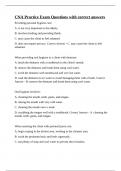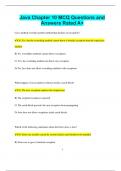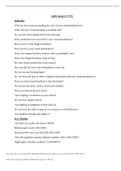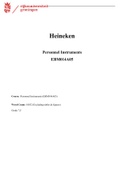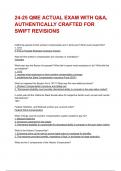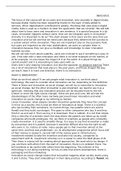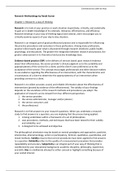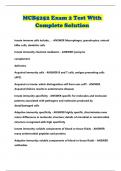Anatomy and Physiology Complete Course Notes Package
Definitions:
Anatomy: the study of structure/morphology of the body and how parts are organized
Physiology: the study of the functions of body parts; what they do and how they do it
Pathophysiology: the study of the diseases of the body
Bodily Organization- Directions, Planes, Cavities, Structural Units
Directions:
Superior- uppermost or above
Inferior- lowermost or below
Anterior- towards the front
Ventral- belly side
Posterior- towards the back
Dorsal- backside
Cephalad/Cranial- towards the head; synonymous with superior
Caudal- towards the tail; synonymous with inferior
Medial- near the midline of the body
Lateral- towards side or away from midline of the body
Proximal- near point of attachment of origin
Distal- away from point of attachment or origin
Planes:
Midsagittal- vertically divides the body midline= equal left and right sides
Sagittal- divides body into unequal left and right sides
Horizontal/Transverse- divides body into superior and inferior positions
Frontal/Coronal- divides anterior/ventral/posterior (dorsal), at right angles to the sagittal plane
Cavities
-Organs in a cavity are called viscera
Dorsal Cavity- contains organs of the nervous system that coordinates the body’s function
-Contains cranial cavity (brain) and spinal cavity (spinal cord)
,Ventral Cavity- contains organs involved in maintaining homeostasis
Thoracic cavity- surrounded by rib cage
Pericardial cavity- contains the heart (pericardial sac)
Pleural cavity- lungs covered by a pleural membrane
Mediastinum- space between two pleural cavities, contains heart, thymus gland, lymph and
blood vessels, trachea, esophagus and nerves
Diaphragm- muscle that separates thoracic cavity from abdominopelvic cavity
Abdominopelvic cavity- contains kidney stomach, liver, gallbladder, small and large intestines,
spleen, pancreas, ovaries and uterus
Parietal- refers to the walls of a cavity
Visceral- refers to the covering of an organ
Cellular Systems Review
Cells are the basic units of life
There are four different types of tissues
Epithelial- covers and protects (skin and inner surfaces of organs)
-forms glands
-lines cavities in the body
-made up of one or more layers of cells
Connective- binds together and supports other organs and tissues
-can be highly specialized (bone, blood, lymph)
-made up of different cells that produce fibres
Muscle- generate movement by shortening and contracting
-made up of elongated cells (referred to as fibres)
Muscle has 3 types:
Skeletal: voluntary
Smooth: involuntary
Cardiac: involuntary, found only in heart
Nervous- made of nerve cells
,-cells from coordinating systems of fibres connect numerous sensory and motor structures of the
body
Systems Review
Integumentary: 2 layers (dermis and epidermis)
-includes skin, hair, nails, sebaceous glands, sweat glands
Function: insulation of body
-protection from UV rays and chemicals
-regulation of body temperature and pressure
Skeletal: includes bone, cartilage, membranous structures, associated with bones
Function: protects soft and vital parts of body
-supports body tissues, bone acts as levers for movement
-manufactures blood cells in red bone marrow, stores fat in yellow bone marrow, stores minerals
like calcium and phosphorous
Muscular: Includes muscles, fasciae (fibrous connective tissue), tendons, bursae (fibrous sacs)
Functions: skeletal- pulls on bones to allow movement
-smooth; pushes food through digestive tract and blood through blood vessels
-cardiac- contraction of heart (heartbeat)
Nervous: consists of brain, spinal cord, cranial nerves, peripheral nerves, sensory and motor
functions of the body
Function- controlling, correlating and regulating other body systems
-interpreting stimuli from our outside world (hot/cold, pain)
-controlling the senses (sight, hearing, taste, smell)
Endocrine: consists of ductless glands, pituitary (master gland), controls thyroid, adrenal glands,
ovaries and testes
Function- works with nervous system through hypothalamus of the brain
-glands produce hormones that chemically regulate bodily functions
Cardiovascular: consists of heart, arteries, veins and capillaries
Function: pump and distribute blood, which carries oxygen, nutrients, waste, to and from cells of
the body
, Lymphatic:
Function- bring oxygen to and eliminate carbon dioxide from the blood
-absorbs fats from intestine and carries them to blood
-protects body from disease by developing immunity and destroying microorganisms
Respiratory: consists of nasal cavities, pharynx, larynx, trachea, bronchi and lungs
Function: bring oxygen and eliminate carbon dioxide from blood
Digestive: consists of alimentary canal (mouth, esophagus, stomach, large and small intestine,
rectum and anus) and its glands (salivary, liver, pancreas)
Function: convert food into simpler substances for absorption by cells
-eliminate indigestible waste
Urinary: consists of two kidneys, two ureters, bladder and urethra
Function: chemical regulation of blood
-formation and elimination of waste
-maintenance of homeostasis
Reproductive: consists of ovaries, uterine tubes (fallopian), uterus, vagina in females and testes,
vas deferens, seminal vesicles, prostate gland, penis and urethra in mails
Function: maintenance of sexual characteristics
-continuation of our species
Homeostasis:
-maintenance of our internal environment of our body
-acts on a negative feedback loop
Quick Chemistry Review Points
-atoms are the smallest particles that maintain all the characteristics of that element
-atoms enter into chemical reactions through their electrons
-atoms consist of a nucleus containing protons and neutrons
-electrons are negatively charged and orbit the nucleus
Elements, Isotopes and Compounds
-element is a substance whose atoms contain the same number of protons and electrons; atoms
are electrically neutral.
Definitions:
Anatomy: the study of structure/morphology of the body and how parts are organized
Physiology: the study of the functions of body parts; what they do and how they do it
Pathophysiology: the study of the diseases of the body
Bodily Organization- Directions, Planes, Cavities, Structural Units
Directions:
Superior- uppermost or above
Inferior- lowermost or below
Anterior- towards the front
Ventral- belly side
Posterior- towards the back
Dorsal- backside
Cephalad/Cranial- towards the head; synonymous with superior
Caudal- towards the tail; synonymous with inferior
Medial- near the midline of the body
Lateral- towards side or away from midline of the body
Proximal- near point of attachment of origin
Distal- away from point of attachment or origin
Planes:
Midsagittal- vertically divides the body midline= equal left and right sides
Sagittal- divides body into unequal left and right sides
Horizontal/Transverse- divides body into superior and inferior positions
Frontal/Coronal- divides anterior/ventral/posterior (dorsal), at right angles to the sagittal plane
Cavities
-Organs in a cavity are called viscera
Dorsal Cavity- contains organs of the nervous system that coordinates the body’s function
-Contains cranial cavity (brain) and spinal cavity (spinal cord)
,Ventral Cavity- contains organs involved in maintaining homeostasis
Thoracic cavity- surrounded by rib cage
Pericardial cavity- contains the heart (pericardial sac)
Pleural cavity- lungs covered by a pleural membrane
Mediastinum- space between two pleural cavities, contains heart, thymus gland, lymph and
blood vessels, trachea, esophagus and nerves
Diaphragm- muscle that separates thoracic cavity from abdominopelvic cavity
Abdominopelvic cavity- contains kidney stomach, liver, gallbladder, small and large intestines,
spleen, pancreas, ovaries and uterus
Parietal- refers to the walls of a cavity
Visceral- refers to the covering of an organ
Cellular Systems Review
Cells are the basic units of life
There are four different types of tissues
Epithelial- covers and protects (skin and inner surfaces of organs)
-forms glands
-lines cavities in the body
-made up of one or more layers of cells
Connective- binds together and supports other organs and tissues
-can be highly specialized (bone, blood, lymph)
-made up of different cells that produce fibres
Muscle- generate movement by shortening and contracting
-made up of elongated cells (referred to as fibres)
Muscle has 3 types:
Skeletal: voluntary
Smooth: involuntary
Cardiac: involuntary, found only in heart
Nervous- made of nerve cells
,-cells from coordinating systems of fibres connect numerous sensory and motor structures of the
body
Systems Review
Integumentary: 2 layers (dermis and epidermis)
-includes skin, hair, nails, sebaceous glands, sweat glands
Function: insulation of body
-protection from UV rays and chemicals
-regulation of body temperature and pressure
Skeletal: includes bone, cartilage, membranous structures, associated with bones
Function: protects soft and vital parts of body
-supports body tissues, bone acts as levers for movement
-manufactures blood cells in red bone marrow, stores fat in yellow bone marrow, stores minerals
like calcium and phosphorous
Muscular: Includes muscles, fasciae (fibrous connective tissue), tendons, bursae (fibrous sacs)
Functions: skeletal- pulls on bones to allow movement
-smooth; pushes food through digestive tract and blood through blood vessels
-cardiac- contraction of heart (heartbeat)
Nervous: consists of brain, spinal cord, cranial nerves, peripheral nerves, sensory and motor
functions of the body
Function- controlling, correlating and regulating other body systems
-interpreting stimuli from our outside world (hot/cold, pain)
-controlling the senses (sight, hearing, taste, smell)
Endocrine: consists of ductless glands, pituitary (master gland), controls thyroid, adrenal glands,
ovaries and testes
Function- works with nervous system through hypothalamus of the brain
-glands produce hormones that chemically regulate bodily functions
Cardiovascular: consists of heart, arteries, veins and capillaries
Function: pump and distribute blood, which carries oxygen, nutrients, waste, to and from cells of
the body
, Lymphatic:
Function- bring oxygen to and eliminate carbon dioxide from the blood
-absorbs fats from intestine and carries them to blood
-protects body from disease by developing immunity and destroying microorganisms
Respiratory: consists of nasal cavities, pharynx, larynx, trachea, bronchi and lungs
Function: bring oxygen and eliminate carbon dioxide from blood
Digestive: consists of alimentary canal (mouth, esophagus, stomach, large and small intestine,
rectum and anus) and its glands (salivary, liver, pancreas)
Function: convert food into simpler substances for absorption by cells
-eliminate indigestible waste
Urinary: consists of two kidneys, two ureters, bladder and urethra
Function: chemical regulation of blood
-formation and elimination of waste
-maintenance of homeostasis
Reproductive: consists of ovaries, uterine tubes (fallopian), uterus, vagina in females and testes,
vas deferens, seminal vesicles, prostate gland, penis and urethra in mails
Function: maintenance of sexual characteristics
-continuation of our species
Homeostasis:
-maintenance of our internal environment of our body
-acts on a negative feedback loop
Quick Chemistry Review Points
-atoms are the smallest particles that maintain all the characteristics of that element
-atoms enter into chemical reactions through their electrons
-atoms consist of a nucleus containing protons and neutrons
-electrons are negatively charged and orbit the nucleus
Elements, Isotopes and Compounds
-element is a substance whose atoms contain the same number of protons and electrons; atoms
are electrically neutral.

